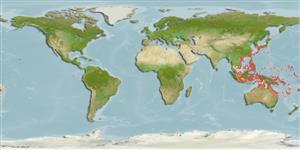Common names from other countries
Environment: milieu / climate zone / depth range / distribution range
Ecologia
marinhas associadas(os) a recifes; intervalo de profundidade 10 - 30 m (Ref. 90102). Subtropical
Western Pacific: Japan, New Guinea, Indonesia, Philippines, Sabah, Palau, and New Caledonia.
Tamanho / Peso / Idade
Maturity: Lm ? range ? - ? cm
Max length : 11.0 cm SL macho/indeterminado; (Ref. 48637)
Descrição suscinta
Chaves de identificação | Morfologia | Morfometria
Espinhos dorsais (total) : 6 - 7; Raios dorsais (total) : 11; Espinhos anais: 1; Raios anais : 10 - 11. Characterized by whitish body color; presence of dark band below eye; clusters of irregular brown spots covering body; 4-5 enlarged brown spots along ventral side; several diffuse brown bars on side; rear edge of dorsal fin with partially ocellated black spot; white coloration on basal portion of pectoral fin; triangular first dorsal fin without prolonged spines; united pelvic fins, well developed frenum present; longitudinal scale series 74-91; head without scales; body covered by cycloid scales; greatest depth of body 5.8-6.5 in SL; rounded caudal fin, a little shorter than head length; reduced posterior oculoscapular sensory canal, single pore (H') present (Ref. 90102).
Inhabits protected sand slopes (Ref. 37816). Lives in clear coastal and inner reefs on rubble flats and slopes (Ref. 48637). Found in burrows together with Alpheus bellulus. Depth range 10-30 (Ref 90102).
Ciclo de vida ou comportamento de acasalamento
Maturities | Reprodução | Spawnings | Egg(s) | Fecundities | Larvas
Masuda, H., K. Amaoka, C. Araga, T. Uyeno and T. Yoshino, 1984. The fishes of the Japanese Archipelago. Vol. 1. Tokai University Press, Tokyo, Japan. 437 p. (text). (Ref. 559)
Status na Lista Vermelha da UICN (Ref. 130435)
CITES (Ref. 128078)
Not Evaluated
Ameaça para os humanos
Harmless
Uso pelos humanos
Ferramentas
Relatórios especiais
Baixar XML
Fontes da internet
Estimates based on models
Preferred temperature (Ref.
115969): 21 - 29, mean 27.8 (based on 158 cells).
Índice de diversidade filogenética (Ref.
82804): PD
50 = 0.5000 [Uniqueness, from 0.5 = low to 2.0 = high].
Bayesian length-weight: a=0.00708 (0.00333 - 0.01504), b=3.09 (2.92 - 3.26), in cm Total Length, based on LWR estimates for this (Sub)family-body shape (Ref.
93245).
Nível Trófico (Ref.
69278): 3.4 ±0.4 se; based on size and trophs of closest relatives
Resiliência (Ref.
120179): Elevada, tempo mínimo de duplicação da população menor que 15 meses (Preliminary K or Fecundity.).
Fishing Vulnerability (Ref.
59153): Low vulnerability (10 of 100).
